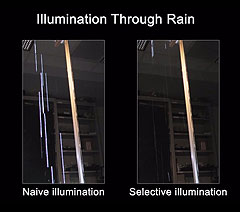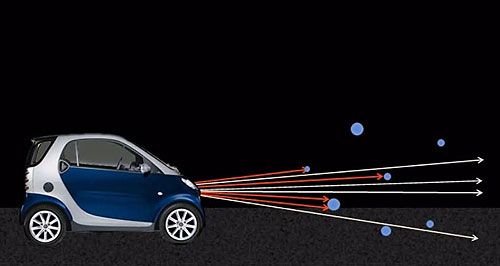Make / Model Search
News - General News - TechnologyHeadlights coming that see through rainBright thinking: Redirecting headlight beams away from raindrops or snowflakes results in slightly dimmer illumination but is claimed to improve visibility. Prototype adaptive headlight said to reduce glare when driving in rain and snow16 Jul 2012 RESEARCHERS in the US have developed a “Smart Headlight” that increases visibility when driving in bad weather at night. The system is claimed to reduce headlight glare reflected by raindrops or even hailstones and snowflakes. An early prototype developed at Carnegie Mellon University in Pittsburgh uses “low-cost off-the-shelf components” including a light projector, digital camera and beam splitter controlled by a Windows PC. Falling raindrops are identified and their path predicted using an algorithm – even when travelling at speed – enabling the part of the beam shining on them to be redirected momentarily, blocking the glare. Associate professor of robotics and member of the Smart Headlight research team Srinivasa Narasimhan said: “If you’re driving in a thunderstorm, the smart headlights will make it seem like it’s a drizzle.” Despite the system resulting in a headlight beam dimmed by up to 10 per cent, its ability to avoid shining a beam on 70 per cent of raindrops (at 30km/h) is claimed to yield large improvements to visibility. Accuracy dropped to just 39 per cent at 110km/h due to the prototype’s reaction time of 13 milliseconds, which the researchers said was limited by the relatively inexpensive hardware used.  Left: A diagram explaining the Smart Headlight technology. Left: A diagram explaining the Smart Headlight technology.However, they claimed that accuracy at 30km/h could increase to 96.8 per cent with a 1.5ms reaction time and suggested that LED headlight units with image sensors and processing hardware integrated into one circuit would enable “extremely high-speed operation at low cost”. The process causes headlights to flicker at a rate of 120 times per second, but Prof Narasimhan said this is undetectable to the human eye. “Because the precipitation particles aren’t being illuminated, the driver won’t see the rain or snow, either,” he said. Researchers are working on a more compact version of the system that can be fitted to a vehicle for on-road testing and are confident that with further development its speed and accuracy will be improved enough to eventually make it viable for use on production cars. Accuracy of the prototype in hail or snow is reduced compared with rain as the algorithm’s ability to accurately calculate in chaotic wind conditions requires further development and more research needs to be done on the system’s ability to cope with vibration. “One good thing is that the system will not fail in a catastrophic way,” said Prof Narasimhan. “If it fails, it is just a normal headlight.” In theory, the system can also be used like existing adaptive headlight systems, which alter the beam to prevent dazzling the drivers of oncoming vehicles, direct it to illuminate corners and highlight potential road hazards. A recent study by the US Highway Loss Data Institute (HLDI) showed drivers of vehicles fitted with adaptive headlights were up to 10 per cent less likely to make insurance claims than those without.  Read more16th of July 2012  Volvo working on animal avoidance techAnimal avoidance, intersection assist and traffic jam ‘autopilot’ for future Volvos6th of July 2012  Mixed results for crash-avoidance techUS insurance study reveals not all crash-avoidance technologies reduce crashes3rd of July 2012  Government considers more safety legislationFederal legislators consider making more safety tech mandatory as road toll declines20th of June 2012  ANCAP announces tighter tests for 2017Amended roadmap focuses on making low-scoring cars safer as ANCAP tightens for 2017 |
Click to shareGeneral News articlesResearch General News Motor industry news |











Facebook Twitter Instagram